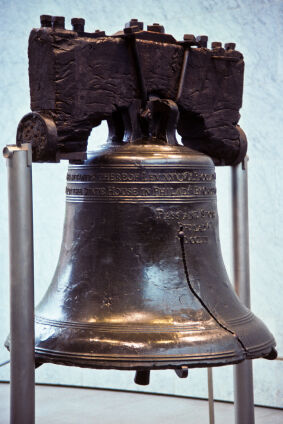
In 1746, construction began on what would become Pennsylvania’s state house. This was Colonial America’s most prestigious public building at the time. In 1751, legislators commissioned a bell that would toll to celebrate important events or a call to gather.
On July 8, 1776, the Liberty Bell rang from the tower of Independence Hall, summoning the citizens of Philadelphia for the first public reading of the Declaration of Independence. If you’re a history fanatic, you may have plans to visit this momentous artifact from American history. But, have you ever wondered what words are engraved on the Liberty Bell? Or what they mean? Wonder no longer, because here are the details.
Words on the Liberty Bell
There are three components to the inscription on the Liberty Bell.
- The first is a Bible verse taken from the book of Leviticus 25:10 and it reads, "Proclaim liberty throughout all the land unto all inhabitants thereof."
This first inscription was appropriately engraved into the Liberty Bell because, in the biblical verse directly preceding verse 10, the Bible references "the fiftieth year." This is no coincidence. The Pennsylvania Assembly ordered the Liberty Bell in 1751 to commemorate the 50th anniversary of William Penn’s Charter of Privileges, which was written in 1701 as Pennsylvania's first Constitution. - The second inscription on the Liberty Bell is, "By order of the Assembly of the Province of Pensylvania for the State House in Philada."
That’s actually the exact spelling used on the Liberty Bell. You probably noticed Pennsylvania is missing an “N.” Also, “Philada” was simply an abbreviation for “Philadelphia” at that time. Today, you’ll be more familiar with the colloquialism “Philly.” If you ever get to visit the second floor of Independence Hall, check out the original maps on the wall. They, too, depict “Pensylvania.” - The final inscription are three words centered on the front of the bell. They are, "Pass and Stow/MDCCLIII."
Pass and Stow are the men who, on two occasions, tried to rectify the cracks that emerged in the bell. On that note, let’s discuss the infamous Liberty Bell crack further.
Pass and Stow
Two men by the name of Pass and Stow entered the scene when a crack appeared in the Liberty Bell. In fact, it arrived in Philadelphia on September 1, 1752 and wasn’t hung until March 10, 1753. Theories abound on how the crack actually happened. Some say it was struck too hard by the clapper. Others believe it was cast too rigidly.
Nevertheless, Pass and Stow were the two foundry workers commissioned to fix the crack. To that end, they added an ounce and a half of copper to the bell, hoping to make it less brittle. Trouble is, nobody liked the tone of the remodeled bell. Pass and Stow were hired again but, this time, they completely recast the bell. Unfortunately, the bell would go on to get cracked again many years later.
Important Moments in History
The Liberty Bell rang out during several important moments in American history. It tolled when Benjamin Franklin traveled to England to address the Colonials’ grievances. It also tolled as a sign of gathering to discuss the Sugar Act of 1764 and the Stamp Act of 1765.
Believe it or not, the crack we see today is a different crack from the original one. It appeared sometime in the early 19th century. One of the most popular theories is that it cracked while ringing after the death of Chief Justice John Marshall.
What we do know is that, in 1864, Philadelphia’s mayor requested that the bell be rung in honor of George Washington’s birthday. Attempts were made to repair the fracture that occured in the early 19th century and the bell did ring out in Washington’s honor. However, this left it with a crack that was beyond repair and the bell was taken out of commission.
If you visit the bell today, know that the crack we see is a result of American people honoring their first president.
Some History Lives on Forever
Clearly, the Liberty Bell played a pivotal role in American Independence. It’s symbolic of victory and death. The fact that it tolled in honor of Benjamin Franklin as he returned to England to take a stand against the British monarchy and fight for the Colonials’ independence is quite significant.
To learn more about this leader during the Revolutionary War, be sure to check out these fascinating facts on the great thinker! Did you know he coined the phrase, “Remember that time is money”? Benjamin Franklin is a fabulous model for the benefits of a disciplined life.